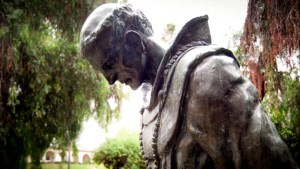Lenten Campaign 2025
This content is free of charge, as are all our articles.
Support us with a donation that is tax-deductible and enable us to continue to reach millions of readers.
Were there abuses of native peoples by Spanish colonists and missionaries? Yes, but don’t make St. Junipero Serra the fall guy, two California archbishops are arguing.
Archbishops José H. Gomez of Los Angeles and Salvatore J. Cordileone of San Francisco wrote in a Wall Street Journal op-ed piece this week that legislation overwhelmingly passed in Sacramento slanders the “Apostle of California” and gets state history seriously wrong.
The state legislature voted to replace a statue of St. Junipero on the capitol grounds with one honoring the “California Native people of the Sacramento, California, region.” Assembly Bill 338, which passed 66–2 in the Assembly and 28–2 in the Senate, has been sent to Gov. Gavin Newsom. It states that indigenous “history and contributions have been relatively ignored, written with great discrepancies and false mythologies.”
The legislation continues, “One of the greatest gaps between history and reality has been the retelling of the mission period in Native American history and the role of Franciscan friar Junipero Serra.” The bill claims that St. Junipero oversaw a mission system that included “enslavement of both adults and children, mutilation, genocide, and assault on women.”
Not so, the two archbishops said in their September 12 Wall Street Journal piece. “While there is much to criticize from this period, no serious historian has ever made such outrageous claims about Serra or the mission system, the network of 21 communities that Franciscans established along the California coast to evangelize native people,” they wrote.
The authors criticized California lawmakers for relying on “a single tendentious book written by journalist Elias Castillo,” A Cross of Thorns: The Enslavement of California’s Indians by the Spanish Missions.
“As leaders of the state’s two largest Catholic communities, we serve thousands of native Californians who trace their faith to ancestors who helped build the missions,” Gomez and Cordileone wrote. “We understand the bitter history of native exploitation. But history can be complicated and facts matter.”
The archbishops described the saint, whom Pope Francis canonized in Washington, D.C., in 2015, as a “complex character,” but one who “defended indigenous people’s humanity, decried the abuse of indigenous women, and argued against imposing the death penalty on natives who had burned down a mission and murdered one of his friends.”
“Serra would surely approve of a new monument honoring the indigenous Californians he spent his life serving,” the archbishops conceded. St. Junipero traveled 2,000 miles to Mexico City when he was aged and infirm “to demand that authorities adopt a native bill of rights he had written,” they said.
Toppled statues
The archbishops claim that Gov. Newsom, who is facing a recall election, “knows California history well enough to see that the claims against Serra aren’t true. In 2019 he apologized for the state’s history of injustice against native people, acknowledging that it was California’s first governor, Peter Burnett, who launched what Burnett called ‘a war of extermination.’”
That war of extermination began more than 60 years after the saint had died, they pointed out.
“The destruction of the state’s native people happened long after he was gone and many of the missions had been taken over by the government,” they said.
The statue of St. Junipero was toppled by protesters in June 2020, in the midst of the Black Lives Matter protests. Since then, it has been in a storage area. Statues of St. Junipero throughout California were vandalized by people believing that he represented oppression against people of color.
There has also been an effort to remove the statue of St. Junipero from Statuary Hall in the United States Capitol.
“How we choose to remember the past shapes the people we hope to be in the future,” Archbishops Gomez and Cordileone wrote. “We can think of no better symbol for this multiethnic state committed to human dignity and equality than to place two statues at the California Capitol — one celebrating the living heritage of California’s indigenous peoples, another reflecting the faith and leadership of their defender St. Junipero Serra.”
Robert M. Senkewicz, history professor emeritus at Santa Clara University and author of Junipero Serra: California, Indians, and the Transformation of a Missionary, said in a 2015 interview with Catholic World Report, that the mission system in California was set up to protect Native Californians from being enslaved.
“Serra and the Franciscans were concerned that the Spanish conquistadors would oppressively dominate” native peoples, he said. “They were concerned that Spanish ranchers, miners, and soldiers would round them up and work them to death. So they founded the missions as a place to convert and protect the Indians. Hence, Serra and the Franciscans saw their role as protecting the Indians.”
The Archdiocese of Los Angeles has more resources on the history of St. Junipero Serra and the California missions.


